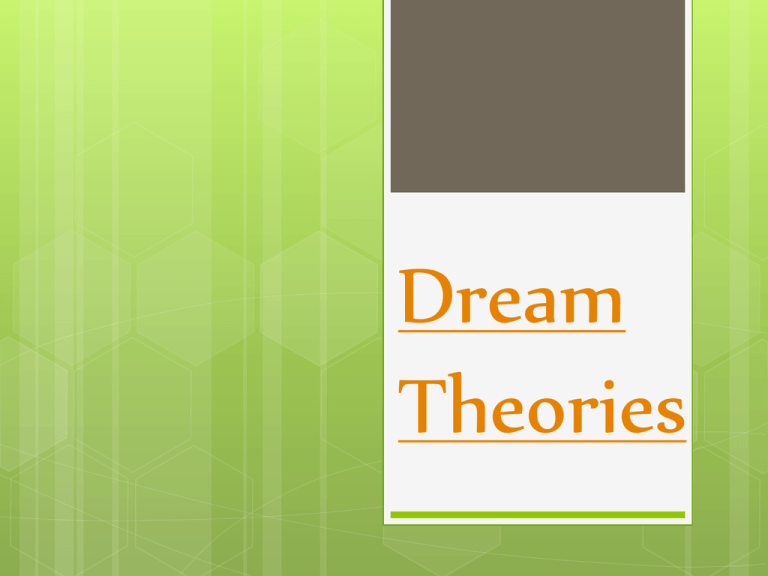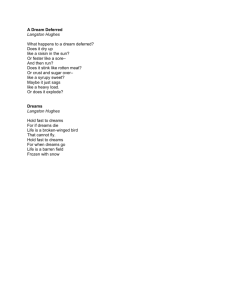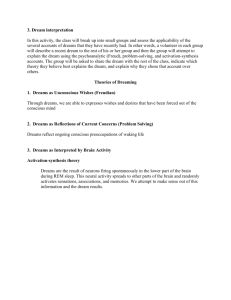
Dream
Theories
The Content of Dreams
Research
shows that the content of dreams is usually
familiar.
Common themes in dreams include things like falling,
being pursued, trying repeatedly to do something, school,
sex, being late, eating, being frightened, etc.
1. Negative Emotional Content: 8 out of 10 dreams
have negative emotional content.
2. Failure Dreams: People commonly dream about
failure, being attacked, pursued, rejected, or
struck with misfortune.
3. Sexual Dreams: Contrary to our thinking, sexual
dreams are sparse. Sexual dreams in men are 1 in
10; and in women 1 in 30.
Why Do We
Dream?
Five Theories
The InformationProcessing Theory
2.
The Physiological
Function Theory
3.
The Cognitive Theory
4.
The ActivationSynthesis Theory
5.
The Wish Fulfillment
Theory
1.
1) Information-Processing Theory
Dreams
may help sift, sort, understand,
and fix a day’s experiences in our
memories.
They may also help us work out unsolved
problems. We go to bed with a problem,
and when we wake up the problem is
solved (or forgotten, which may be a
solution in itself).
When we are under stress or depressed,
we sleep longer, and the amount of time
spent in REM increases. This fact strongly
suggests that we are working on the
things that are worrying us while we
dream.
Dreams
are more likely to contain material
related to a person’s current concerns than
chance would predict.
Students
dream about exams
Instructors dream of forgetting lecture notes
Males
and females appear to dream about
similar issues now that lives and concerns of
the two sexes have become similar.
Women
children, clothes, household objects
Men weapons, violence, sex, achievement
2) Physiological Function Theory
Brain
chemicals are used up during the day
(notice how hard it is to study after a long,
hard day).
Because the brain cannot remain completely
inactive while it replenishes these chemicals,
dreams keep the brain busy with old material
(versus new material, which takes more
chemicals to process) while it is being
“recharged.”
Dreams provide the sleeping brain with periodic
stimulation to develop and preserve neural
pathways.
For example, the neural networks of newborns
are quickly developing; therefore, they need
more sleep.
3) Cognitive Development Theory
Some
researchers argue that we dream as a part
of brain maturation and cognitive development.
Children’s dreams appear to differ from those of
adults:
Preschool children report bland images with no
story-lines when awoken from REM sleep (if they
recall dreaming at all – children under the age
of 9-11 report dreaming only 20-30% of the time
when awoken from REM sleep, as opposed to
an adult’s 80% of the time).
Between 5 and 8, children begin to report
dream narratives, but these are not well
developed.
Adult-like dreams develop at around 11-13,
suggesting that dreaming is a cognitive ability
that develops gradually.
4) The Activation-Synthesis Theory
During
the night, our brainstem releases
random neural activity.
The
brain tries to make sense of the random
bits and pieces of information that are
appearing, so it makes up a “story” to fit them.
At
the same time, brain regions that handle
logical thought and sensation from the
external world are shut down. This would
account for why we so often put odd things
together in a dream.
5) Wish Fulfillment
People in Western cultures pay little attention
to dreams as meaningful messages in their
lives, while people from many non-Western
cultures are likely to view dreams as important
information about themselves, the future, or
the spiritual world.
First
and foremost in dream theory is
Sigmund Freud.
the father of psychoanalysis
Revolutionized the study of dreams with his
book The Interpretation Of Dreams
He called dreams “the royal road to the
unconscious.”
Considered
According
to Freud…
We all have desires and
urges that are not
considered acceptable by
society
We hold these back –
repress them
BUT they get released in
different ways by our
unconscious
One way is through our
dreams
Freud’s Dream Theory: Wish
Fulfillment
Dreams
function to virtually fulfill:
Your
unexpressed wishes
Your
ungratified needs
Dreams
are combinations of early
and recent experiences
involve childhood memories and early parental
relationships
Freud’s View on How
Our Minds Work:
Your
dreams have 2
levels:
MANIFEST – what you
actually dream about
LATENT – what your dream
really means ---- this is based
on symbolism
So…What do Our
Dreams Tell Us
about Ourselves???
Dreams reveal what is going on
in your unconscious
Your unconscious can act out
your hidden desires because
you are asleep
BUT – your desires can be so
odd and disturbing that your
mind might still “censor” them
This results in your dreams being
symbolic
Your sleep isn’t disturbed and
you don’t wake up as a result of
being shocked about the
images in your dreams
It results in cryptic and
confusing dreams, though
Dream Theories
Summary






